The Time Period When Europeans Became Influenced Again by the Roman and Greek Writings
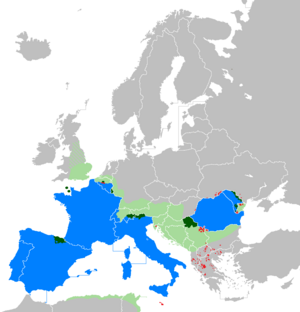
Official Romance linguistic communication
Co-official Romance language
Unofficial Romance linguistic communication
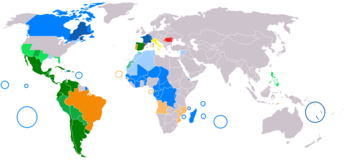
The legacy of the Roman Empire has been varied and meaning, comparable to that of other hegemonic polities of world history (e.1000. Farsi Empire, ancient Egypt or imperial China).
The Roman Empire, itself built upon the legacy of other cultures, has had long-lasting influence with wide geographical reach on a great range of cultural aspects, including country institutions, police force, cultural values, religious beliefs, technological advances, engineering and language.
This legacy survived the demise of the empire itself (fifth century Advertizement in the West, and 15th century Advert in the E) and went on to shape other civilisations, a procedure which continues to this solar day. The city of Rome was the civitas (reflected in the etymology of the word "civilisation") and connected with the actual western civilization on which subsequent cultures built.
One main legacy is the Latin Linguistic communication of ancient Rome, epitomized by the Classical Latin used in Latin literature, which evolved during the Center Ages and remains in utilize in the Roman Cosmic Church as Ecclesiastical Latin. Vulgar Latin, the mutual tongue used for regular social interactions, evolved simultaneously into the various Romance languages that exist today (notably Italian, French, Castilian, Portuguese, Romanian, Catalan, Sardinian, etc.). Although the Western Roman Empire fell in the fifth century Advert, the Eastern Roman Empire continued until its conquest past the Ottoman Empire in the 15th century Advertizing and cemented the Greek language in many parts of the Eastern Mediterranean even after the Early Muslim conquests of the 7th century Advertisement. Although there has been a small modern revival of the Hellenistic religion with Hellenism, aboriginal Roman paganism was largely displaced by Roman Catholic Christianity after the 4th century AD and the Christian conversion of Roman emperor Constantine I (r. 306-337 AD). The Christian faith of the late Roman Empire continued to evolve during the Eye Ages and remains a major facet of the organized religion and the psyche of the modernistic Western world.
Aboriginal Roman compages, largely indebted to ancient Greek compages of the Hellenistic period, has influenced the architecture of the Western earth, particularly during the Italian Renaissance of the 15th century. Roman law and republican politics (from the age of the Roman Democracy) have left an enduring legacy, influencing the Italian city-state republics of the Medieval period equally well as the early U.s.a. and other modern democratic republics. The Julian calendar of aboriginal Rome formed the basis of the standard modern Gregorian calendar, while Roman inventions and engineering science, such equally the construction of physical domes, continued to influence various peoples after the fall of Rome. Roman models of colonialism and of warfare likewise became influential.
Language [edit]
Latin became the lingua franca of the early Roman Empire and later of the Western Roman Empire, while - specially in the Eastern Roman Empire - ethnic languages such as Greek and to a lesser degree Egyptian and Aramaic language continued in use. Despite the turn down of the Western Roman Empire, the Latin linguistic communication connected to flourish in the very different social and economic environment of the Middle Ages, not least because it became the official linguistic communication of the Roman Catholic Church building. Koine Greek, which served equally a lingua franca in the Eastern Empire, remains in use today equally a sacred language in some Eastern Orthodox churches.
In Western and Central Europe and in parts of northern Africa, Latin retained its elevated condition as the main vehicle of communication for the learned classes throughout the Middle Ages and later on; witness particularly the Renaissance and Baroque periods. Books which had a revolutionary touch on on science, such as Nicolaus Copernicus' De revolutionibus orbium coelestium (1543), were composed in Latin. This language was not supplanted for scientific purposes until the 18th century, and for formal descriptions in zoology, likewise equally botany - information technology survived to the afterwards 20th century.[i] The modern international binomial nomenclature holds to this day: taxonomists assign a Latin or Latinized name every bit the scientific proper name of each species.
In the 21st century the Romance languages, which comprise all languages that descended from Latin, are spoken by more than 920 million people as their mother tongue, and by 300 million people equally a second language, mainly in the Americas, Europe, and Africa.[2] Romance languages are either official, co-official, or significantly used in 72 countries around the world.[3] [ failed verification ] [4] [v] [half dozen] [vii] [8] Of the United Nations' six official languages, 2 (French and Spanish) descend from Latin.
Additionally, Latin has had a bang-up influence on the lexicon of W Germanic languages. Romance words make respectively 59%, xx% and fourteen% of English language, German and Dutch vocabularies.[9] [10] [11] Those figures tin rise dramatically when only non-chemical compound and non-derived words are included. Accordingly, Romance words make roughly 35% of the vocabulary of Dutch.[11] Of all the loanwords in Dutch, 32.2% come up directly from some form of Latin (excluding loans from Romance languages).[12] Over 60% of Albanian vocabulary consist of Latin roots, causing Albanian to one time accept been mistakenly identified as a Romance language.[13]
Script [edit]
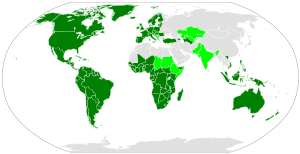
All three official scripts of the modernistic European union—Latin, Greek and Cyrillic—descend from writing systems used in the Roman Empire. Today, the Latin script, the Latin alphabet spread by the Roman Empire to most of Europe, and derived from the Phoenician alphabet through an ancient form of the Greek alphabet adopted and modified past Etruscan, is the most widespread and ordinarily used script in the world. Spread past various colonies, merchandise routes, and political powers, the script has continued to abound in influence. The Greek alphabet, which had spread throughout the eastern Mediterranean region during the Hellenistic menses, remained the principal script of the Eastern Roman Empire through the Byzantine Empire until its demise in the 15th century. Cyrillic scripts largely derive from the Greek.[xiv]
Latin literature [edit]

15th-century printed books by language.[15] The high prestige of Latin meant that that linguistic communication still dominated European published discourse a millennium after the demise of the Western Roman Empire.
The Carolingian Renaissance of the eighth century rescued many works in Latin from oblivion: manuscripts transcribed at that time are our but sources for some works that afterward fell into obscurity once more, only to be recovered during the Renaissance: Tacitus, Lucretius, Propertius and Catullus replenish examples.[16] Other Latin writers never went out of apportionment: Virgil, reinterpreted as a prophet of Christianity past the 4th century, gained the reputation of a wizard in the 12th century.
Cicero, in a limited number of his works, remained a model of adept style, mined for quotations. Medieval Christians read Ovid allegorically, or re-imagined Seneca as the correspondent of Saint Paul. Lucan, Persius, Juvenal, Horace, Terence, and Statius survived in the continuing canon and the historians Valerius Maximus and Livy connected to exist read for the moral lessons history was expected to impart.
Through the Roman Empire, Greek literature also continued to make an impact in Europe long after the Empire'due south autumn, especially after the recovery of Greek texts from the Eastward during the high Middle Ages and the resurgence of Greek literacy during the Renaissance. Many educated Westerners from the Renaissance up to the 20th century, for instance, read Plutarch'due south Lives of the Noble Greeks and Romans, originally written in Greek. Shakespeare's play Julius Caesar takes almost of its material from Plutarch's biographies of Caesar, Cato, and Brutus, whose exploits were oft discussed and debated by the literati of Shakespeare's time.
Didactics [edit]
Martianus Capella adult the system of the seven liberal arts that structured medieval education. Although the liberal arts were already known in Aboriginal Hellenic republic, information technology was but after Martianus that the vii liberal arts took on canonical course. His unmarried encyclopedic piece of work, De nuptiis Philologiae et Mercurii "On the Marriage of Philology and Mercury", laid the standard formula of academic learning from the Christianized Roman Empire of the 5th century until the Renaissance of the twelfth century.
The seven liberal arts were formed by the trivium, which included the skills of grammar, logic, and rhetoric, while arithmetic, geometry, music, and astronomy played part every bit the quadrivium.
Calendar and measurement [edit]
The modern Western agenda is a refinement of the Julian agenda, which was introduced by Julius Caesar. The calendar of the Roman Empire began with the months Ianuarius (Jan), Februarius (Feb), and Martius (March). The common tradition to begin the year on 1 January was a convention established in ancient Rome. Throughout the medieval period, the year began on 25 March, the Catholic Solemnity of the Declaration.
The 5th-century Roman monk Dionysius Exiguus devised the modern dating organisation of the Anno Domini (AD) era, which is based on the reckoned year of the nascence of Jesus, with AD counting years from the get-go of this epoch, and BC cogent years earlier the outset of the era.
The modern seven-day week follows the Greco-Roman organization of planetary hours, in which one of the seven heavenly bodies of the Solar System that were known in ancient times—Saturn, Jupiter, Mars, the Sun, Venus, Mercury and the Moon—is given "rulership" over each twenty-four hour period. The Romance languages (with the exception of Portuguese, that assigns an ordinal number to five days of the week, from Monday to Friday, starting time with segunda-feira , and ending with sexta-feira ) preserve the original Latin names of each day of the week, except for Sunday, which came to be chosen dies dominicus (Lord's Day) nether Christianity.
| Solar day | Sunday Sōl (Sun) | Mon Luna (Moon) | Tuesday Mars (Mars) | Wednesday Mercurius (Mercury) | Thursday Iuppiter (Jupiter) | Friday Venus (Venus) | Sat Saturnus (Saturn) |
|---|---|---|---|---|---|---|---|
| Latin | dies Sōlis | dies Lūnae | dies Martis | dies Mercuriī | dies Iovis | dies Veneris | dies Saturnī |
| Italian | domenica | lunedì | martedì | mercoledì | giovedì | venerdì | sabato |
| French | dimanche | lundi | mardi | mercredi | jeudi | vendredi | samedi |
| Spanish | domingo | lunes | martes | miércoles | jueves | viernes | sábado |
| Romanaian | duminică | luni | marți | miercuri | joi | vineri | sâmbătă |
| Catalan | diumenge | dilluns | dimarts | dimecres | dijous | divendres | dissabte |
Hours of the solar day [edit]
The 12-60 minutes clock is a time convention popularized by the Romans in which the 24 hours of the 24-hour interval are divided into two periods. The Romans divided the day into 12 equal hours, A.M. (ante-meridiem, meaning before midday) and P.M. (mail service-meridiem, meaning past midday). The Romans too started the practice used worldwide today of a new day first at midnight.
Numerals and units [edit]
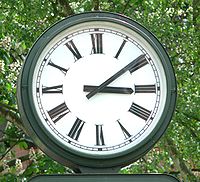
Roman numerals continued as the primary way of writing numbers in Europe until the 14th century, when they were largely replaced in mutual usage by Hindu–Arabic numerals. The Roman numeral system continues to be widely used, yet, in certain formal and minor contexts, such as on clock faces, coins, in the year of construction on cornerstone inscriptions, and in generational suffixes (such as Louis Fourteen or William Howard Taft IV). Romance languages (and also other languages such as Russian, Polish and Basque) write centuries in Roman numbers; in Castilian, for example, "21st century" is written siglo XXI.
The Romans solidified the modern concept of the hour as i-24th part of a mean solar day and night. The English measurement organization besides retains features of the Aboriginal Roman foot (11.65 mod inches), which was used in England prior to the Anglo-Saxon settlement of Britain. The inch itself derives from the Roman uncia , meaning i-twelfth part.
3-age systems [edit]
Although the nowadays archaeological organisation of the iii main ages—stone, statuary and iron—originates with the Danish archaeologist Christian Jürgensen Thomsen, the concept of dividing pre-historical ages into systems based on metals extends to Ancient Rome, originated by the Roman Lucretius in the beginning century BC.[ citation needed ]
Religion [edit]
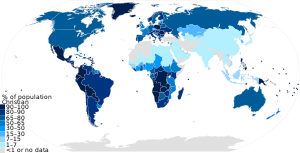
While classical Roman and Hellenistic religion were ultimately superseded by Christianity, many fundamental theological ideas and questions that are characteristic of Western religions originated with pre-Christian theology. The first cause argument for the existence of God, for instance, originates with Plato. Design arguments, which were introduced by Socrates and Aristotle and remain widely discussed to this twenty-four hours, formed an influential component of Stoic theology well into the late Roman period. The problem of evil was widely discussed among aboriginal philosophers, including the Roman writers such as Cicero and Seneca, and many of the answers they provided were later on absorbed into Christian theodicy. In Christian moral theology, moreover, the field of natural law ethics draws heavily on the tradition established by Aristotle, the Stoics, and especially by Cicero's pop Latin work, De Legibus. Cicero'due south conception of natural law "plant its style to later on centuries notably through the writings of Saint Isidore of Seville and the Decretum of Gratian"[17] and influenced the discussion of the topic up through the era of the American Revolution.
Christianity itself as well spread through the Roman Empire; since emperor Theodosius I (AD 379-395), the official land church of the Roman Empire was Christianity. Later, former Roman territories became Christian states which exported their religion to other parts of the globe, through colonization and missionaries.
Christianity also served every bit a conduit for preserving and transmitting Greco-Roman literary civilisation. Classical educational tradition in the liberal arts was preserved after the fall of the empire past the medieval Christian academy. Education in the Middle Ages relied heavily on Greco-Roman books such as Euclid'southward Elements and the influential quadrivium textbooks written in Latin past the Roman statesman Boethius (AD 480–524).
Major works of Greek and Latin literature, moreover, were both read and written by Christians during the purple era. Many of the about influential works of the early Christian tradition were written by Roman and Hellenized theologians who engaged heavily with the literary culture of the empire (meet church fathers). St. Augustine's (Advertisement 354-430) City of God, for instance, draws extensively on Virgil, Cicero, Varro, Homer, Plato, and elements of Roman values and identity to criticize paganism and advocate for Christianity amid a crumbling empire. The date of early on Christians as both readers and writers of important Roman and Greek literature helped to ensure that the literary civilization of Rome would persist subsequently the fall of the empire. For thousands of years to follow, religious scholars in the Latin West from Bede to Thomas Aquinas and later renaissance figures such as Dante, Montaigne and Shakespeare would go on to read, reference and imitate both Christian and pagan literature from the Roman Empire. In the east, the empire'southward prolific tradition of Greek literature continued uninterrupted after the fall of the westward, in part due to the works of the Greek fathers, who were widely read past Christians in medieval Byzantium and go on to influence religious thought to this day (see Byzantine literature).
Science and philosophy [edit]
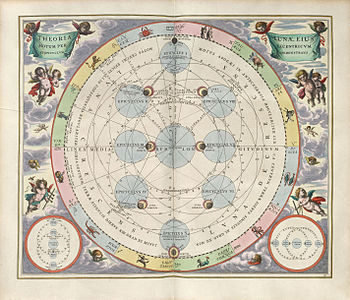
Ptolemy's refined geocentric theory of epicycles was backed up by rigorous mathematics and detailed astronomical observations. It was not overturned until the Copernican Revolution, over a thousand years later.

The Bible as codex. The codex, the book format today in universal employ, was invented by the Romans and spread by Roman Christians.[18]
While much of the most influential Greek scientific discipline and philosophy was adult before the rise of the Empire, major innovations occurred under Roman rule that accept had a lasting impact on the intellectual world. The traditions of Greek, Egyptian and Babylonian scholarship continued to flourish at swell centers of learning such as Athens, Alexandria, and Pergamon.
Epicurean philosophy reached a literary apex in the long poem by Lucretius, who advocated an atomic theory of matter and revered the older teachings of the Greek Democritus. The works of the philosophers Seneca the Younger, Epictetus and the Roman emperor Marcus Aurelius were widely read during the revival of Stoic thought in the Renaissance, which synthesized Stoicism and Christianity. Fighter pilot James Stockdale famously credited the philosophy of Epictetus every bit beingness a major source of force when he was shot down and held equally prisoner during the Vietnam War. Plato'due south philosophy connected to be widely studied under the Empire, growing into the sophisticated neoplatonic arrangement through the influence of Plotinus. Platonic philosophy was largely reconciled with Christianity past the Roman theologian Augustine of Hippo, who, while a staunch opponent of Roman paganism, viewed the Platonists equally having more than in common with Christians than the other heathen schools.[19] To this twenty-four hour period, Plato'due south Republic is considered the foundational work of Western philosophy, and is read by students around the earth.
The widespread Lorem ipsum text, which is widely used as a meaningless placeholder in modern typography and graphic blueprint, is derived from the Latin text of Cicero's philosophical treatise De finibus.
Pagan philosophy was gradually supplanted past Christianity in the after years of the Empire, culminating in the closure of the Academy of Athens past Justinian I. Many Greek-speaking philosophers moved to the east, outside the borders of the Empire. Neoplatonism and Aristotelianism gained a stronghold in Persia, where they were a heavy influence on early on Islamic philosophy. Thinkers of the Islamic Golden Age such equally Ibn Sina (Avicenna) and Ibn Rushd (Averroës) engaged deeply with Greek philosophy, and played a major role in saving works of Aristotle that had been lost to the Latin W. The influence of Greek philosophy on Islam was dramatically reduced In the 11th century when the views of Avicenna and Avveroes were strongly criticized by Al-Ghazali. His Incoherence of the Philosophers is amidst the nigh influential books in Islamic history. In Western Europe, meanwhile, the recovery of Greek texts during the Scholastic menses had a profound influence on Latin scientific discipline and theology from the Middle Ages into the Renaissance.
In science, the theories of the Greco-Roman md Galen dominated Western medical thought and do for more than 1,300 years. Ptolemy produced the most thorough and sophisticated astronomical theory of antiquity, documented in the Almagest. The Ptolemaic model of the solar system would remain the dominant approach to astronomy beyond Europe and the Middle East for more than a chiliad years. Forty 8 of the 88 constellations the IAU recognizes today were recorded in the seventh and eighth books of Claudius Ptolemy's Almagest.
At Alexandria, the engineer and experimentalist Hero of Alexandria founded the report of mechanics and pneumatics. In mod geometry, Heron's formula bears his name. Roman Alexandria also saw the seeds of modern algebra arise in the works of Diophantus. Greek algebra continued to be studied in the east well after the fall of the Western Empire, where it matured into modern algebra in the hands of al-Khwārizmī (meet the history of algebra). The study of Diophantine Equations and Diophantine Approximations are still of import areas of mathematical research today.
All of the planets in the Solar System, excluding Earth and Uranus, in the English linguistic communication, are named subsequently Roman deities.
Roman law and politics [edit]
Although the law of the Roman Empire is non used today, modern law in many jurisdictions is based on principles of police force used and developed during the Roman Empire. Some of the same Latin terminology is nonetheless used today. The general structure of jurisprudence used today, in many jurisdictions, is the same (trial with a gauge, plaintiff, and defendant) as that established during the Roman Empire.
The modern concept of republican government is straight modeled on the Roman Republic. The republican institutions of Rome survived in many of the Italian city-states of the Middle Ages and the Renaissance. The United states of america Congress is inspired by the Roman senate and legislative assemblies, while the president holds a position similar to that of a Roman consul. Many European political thinkers of the Enlightenment were gorging consumers of Latin literature. Montesquieu, Edmund Burke, and John Adams were all strongly influenced by Cicero, for case. Adams recommended Cicero equally a model for politicians to imitate, and once remarked that "the sweetness and grandeur of his sounds, and the harmony of his numbers give pleasance enough to advantage the reading if one understood none of his significant."[20]
Inventions [edit]

Gnocchi, a kind of traditional Italian pasta, was introduced to diverse parts of Europe by the Roman legions during the expansion of the empire.
Many Roman inventions were improved versions of other people's inventions and ranged from military organization, weapon improvements, armour, siege technology, naval innovation, architecture, medical instruments, irrigation, civil planning, construction, agronomics and many more areas of borough, governmental, military machine and applied science development.
That said, the Romans also developed a huge array of new technologies and innovations. Many came from mutual themes but were vastly superior to what had come earlier, whilst others were totally new inventions adult by and for the needs of Empire and the Roman way of life.
Some of the more than famous examples are the Roman aqueducts (some of which are still in employ today), Roman roads, h2o powered milling machines, thermal heating systems (as employed in Roman baths, and as well used in palaces and wealthy homes) sewage and pipe systems and the invention and widespread use of concrete.
Metallurgy and drinking glass work (including the first widespread use of glass windows) and a wealth of architectural innovations including high rise buildings, dome structure, bridgeworks and floor structure (seen in the functionality of the Colosseum'southward arena and the underlying rooms/areas beneath it) are other examples of Roman innovation and genius.
Armed forces inventiveness was widespread and ranged from tactical/strategic innovations, new methodologies in grooming, field of study and field medicine also as inventions in all aspects of weaponry, from armor and shielding to siege engines and missile engineering.
This combination of new methodologies, technical innovation, and creative invention in the military gave Rome the edge confronting its adversaries for half a millennium, and with it, the power to create an empire that even today, more than than 2000 years later, continues to go out its legacy in many areas of modern life.
Colonies and roads [edit]
Rome left a legacy of founding many cities equally Colonia. There were more than 500 Roman colonies spread through the Empire, most of them populated by veterans of the Roman legions. Some Roman colonies rose to become influential commercial and trade centers, transportation hubs and capitals of international empires, like Constantinople, London, Paris and Vienna.
All those colonies were connected by another of import legacy of the Roman Empire: the Roman roads. Indeed, the empire comprised more than 400,000 kilometres (250,000 mi) of roads, of which over eighty,500 kilometres (l,000 mi) were rock-paved.[21] The courses (and sometimes the surfaces) of many Roman roads survived for millennia and many are overlaid by modern roads, similar the Via Emilia in northern Italy. The roads are closely linked to modernistic-day economies, with those that survived from the empire's territorial peak in 117 CE having more economic activity today. This is especially true in European areas, which kept wheeled vehicles in the latter half of the first millennium, whereas other regions preferred cheaper methods of transport such as camel caravans.[22]
Architecture [edit]
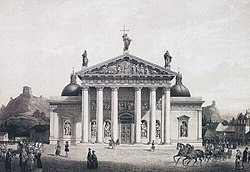
In the mid-18th century, Roman architecture inspired neoclassical architecture. Neoclassicism was an international motion. Though neoclassical architecture employs the aforementioned classical vocabulary as late Baroque architecture, it tends to emphasize its planar qualities, rather than sculptural volumes. Projections and recessions and their furnishings of light, and shade are flatters; sculptural bas-reliefs are flatter and tend to be enframed in friezes, tablets or panels. Its clearly articulated private features are isolated rather than interpenetrating, autonomous and complete in themselves.
International neoclassical architecture was exemplified in Karl Friedrich Schinkel's buildings, especially the Onetime Museum in Berlin, Sir John Soane'due south Banking concern of England in London and the newly congenital White House and Capitol in Washington, DC in the United States. The Scots builder Charles Cameron created palatial Italianate interiors for the High german-born Catherine II the Great in St. petersburg.
Italy clung to Rococo until the Napoleonic regimes brought the new archaeological classicism, which was embraced as a political statement by immature, progressive, urban Italians with republican leanings.
Imperial idea [edit]
From a legal point of view, the Roman Empire, founded past Augustus in 27 BC and divided after the death of Theodosius I in 395 into two "parts" (or rather courts, as the empire continued to be considered every bit one), had survived simply in the eastern function which, with the degradation of the concluding western emperor Romulus Augustulus in 476, had as well obtained the majestic regalia of the western part reuniting from a formal betoken of view the Roman Empire.
The Roman line connected uninterrupted to rule the Eastern Roman Empire, whose main characteristics were Roman concept of land, medieval Greek culture and language, and Orthodox Christian organized religion. The Byzantines themselves never ceased to refer to themselves as "Romans" (Rhomaioi) and to their state as the "Roman Empire", the "Empire of the Romans" (in Greek Βασιλεία των Ῥωμαίων, Basileía ton Rhōmaíōn) or "Romania" (Ῥωμανία, Rhōmanía). Likewise, they were chosen "Rûm" (Rome) by their eastern enemies to the point that competing neighbours fifty-fifty acquired its proper noun, such as the Sultanate of Rûm.
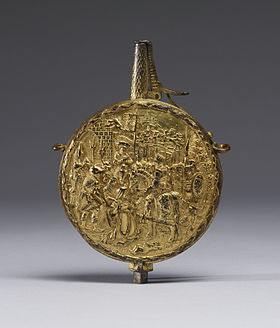
Flask for Priming Power with the Justice of Trajan (mid-16th century), depicting a woman's plea for justice from Trajan, with an regal pennant of the Habsburgs suggesting that as Holy Roman Emperors they are the political descendants of the ancient Roman emperors (Walters Art Museum)
The designation of the Empire as "Byzantine" is a retrospective idea: it began only in 1557, a century after the fall of Constantinople, when German historian Hieronymus Wolf published his work Corpus Historiæ Byzantinæ, a collection of Byzantine sources. The term did not come in full general apply in the Western world before the 19th century,[ citation needed ] when modernistic Greece was built-in. The end of the continuous tradition of the Roman Empire is open to debate: the final point may be viewed as coming every bit early every bit the sack of Constantinople in 1204, or the capture of Constantinople in 1453, or as tardily as the abolition of the Ottoman sultanate in 1922 given the Sultans' adoption of the title of Emperor of the Romans (Kayser-i Rum) for themselves.
After the autumn of Constantinople, Thomas Palaiologos, brother of the terminal Eastern Roman Emperor, Constantine XI, was elected emperor and tried to organize the remaining forces. His rule came to an end later the fall of the last major Byzantine city, Corinth. He then moved to Italy and connected to be recognized as Eastern emperor by the Christian powers.
His son Andreas Palaiologos continued claims on the Byzantine throne until he sold the championship to Ferdinand 2 of Aragon and Isabella I of Castile before his decease in 1502.[23] However, there is no evidence that whatsoever Spanish monarch used the Byzantine majestic titles.
In Western Europe, the Roman concept of land was continued for almost a millennium past the Holy Roman Empire whose emperors, mostly of German natural language, viewed themselves as the legitimate successors to the ancient imperial tradition (Rex of the Romans) and Rome equally the capital of its Empire. The German title of "Kaiser" is derived from the Latin name Caesar, which is pronounced [ˈkae̯sar] in Classical Latin.
The coronation of Charlemagne equally "Roman" emperor by Pope Leo III in the year 800 happened at a time of unprecedented sole female regal dominion in Constantinople (by Empress Irene) which was interpreted by adversaries as tantamount to a vacancy. The regal title in the West generated what historians have chosen the trouble of ii emperors. The emperors of the Holy Roman Empire sought in many ways to brand themselves accustomed by the Byzantines every bit their peers: with diplomatic relations, political marriages or threats. Sometimes, nevertheless, they did not obtain the expected results, because from Constantinople they were e'er called "King of the Germans", never "Emperor." The Holy Roman Empire survived Byzantium, but was eventually dissolved in 1806 attributable to force per unit area by Napoleon I.
In Eastern Europe, firstly the Bulgarian, then the Serbian and ultimately the Russian czars (Czar derived from Caesar) proclaimed being Emperors. In Moscow in Russia adopted the idea of being a 3rd Rome (with Constantinople being the second). Sentiments[ commendation needed ] of being the heir of the fallen Eastern Roman Empire began during the reign of Ivan Three, Grand Duke of Moscow who had married Sophia Paleologue, the niece of Constantine XI (it is important to note that she was non the heiress of the Byzantine throne, rather her brother Andreas was). Being the most powerful Orthodox Christian state, the Tsars were idea of in Russia as succeeding the Eastern Roman Empire as the rightful rulers of the Orthodox Christian earth.[ commendation needed ] The House of Romanov, being the rulers of the Russian Empire, were finally ended in the Russian Revolution of 1917.[24] In that location were also competing Bulgarian and Wallachian[25] [26] claims for succession of the Roman Empire.
In the early 20th century, the Italian fascists under their "Duce" Benito Mussolini dreamed of transforming Italian republic back into the Roman Empire once more, encompassing the Mediterranean basin.[27] Associated with Italian fascism also Nazi Germany and Francoist Spain connected their claims with Roman imperialism.[ how? ]
Toponymy and ethnonymy [edit]
Bated from the urban center of Rome itself, the Imperial Roman name has survived in a number of regions and was also adopted past some of the political regimes that ruled them. These include:
- Romagna, the Italian region that was the authoritative centre of Byzantine Italy and thus remained associated with the Roman Empire when most of the country had fallen under Lombard rule;
- Rûm, the name by which the Seljuq Turks referred to the parts of Anatolia which they had conquered from the Eastern Roman Empire, thus the common proper noun of the Sultanate of Rum for their realm (1077-1308).[28] Under the Ottoman Empire after the 1390s, the Rûm Eyalet was the region around Sivas, later known simply as Eyalet of Sivas.
- The name of the Turkish urban center of Erzurum has been derived from the Arabic Arḍ ar-Rūm (Arabic: ارض الروم) 'state of the Rûm'.[29] [thirty]
- Romania, a habitual reference in medieval Latin and Romance languages to the Byzantine Empire, or between 1204 and 1261 to the Latin Empire. It survived for a fourth dimension in identify names such equally that of Nafplio, which in Italian was referred to as Napoli in Romania well into the modern era, or to this twenty-four hours in the Bosnian region of Romanija.
- Rumelia, the Balkanic parts of the former Eastern Empire, labelled "land of the Romans" post-obit their conquest by the Ottomans and at a time when the Asia Modest territories formerly known every bit Rum were more unremarkably referred to again as Anatolia.
- Cardinal Hellenic republic is nonetheless known colloquially as Roúmeli (Ρούμελη).
- The modern country of Romania. Romanians trace their origin to the Roman Empire's province of Roman Dacia, arguing that Roman colonization in the region gave rise to the Romanian people.
- The Aromanians, Megleno-Romanians and Istro-Romanians, ethnicities related to the Romanians whose names originate or originated from "Roman" or similar words.[31] [32] [33]
In linguistics and ethnonymy:
- The word Romance, naming the language family that also includes Spanish, Portuguese, French, Italian and Romanian among others, is itself derived from "Roman".
- Rûm in Asia Minor and the Middle Eastward refers dependent on context to Byzantines and/or Orthodox Christians, namely the Rum Millet in the Ottoman Empire. Correspondingly, Orthodox Armenians are known as Hayhurum - literally, Armenian and Rûm - and Urums are Turkic-speaking Orthodox Christians in the Crimea and Georgia.
- Romaniote Jews also derive their name from the one-time Eastern/Byzantine/Ottoman Empire.
- In plow, during the 16th century, Portuguese used "rume" and "rumes" (plural) as a generic term to refer to the Mamluk-Ottoman forces they faced then in the Indian Ocean.[34]
- Chinese authors during the Ming dynasty similarly referred to the Ottomans in general every bit Lumi (魯迷), derived from Rûm. During the Qing dynasty they too used the give-and-take Wulumu (務魯木).
- The Romani people, past contrast, are named afterwards an unrelated Sanskrit root common with the Domba people in Bharat.
Run across also [edit]
- Western Roman Empire
- Byzantine Empire
- Third Rome
Full general:
- Classical antiquity
- Classical tradition
- History of the Roman Empire
References [edit]
- ^ Run across History of Latin.
- ^ "Romance languages". Britannica.com. Retrieved 2018-11-24 .
- ^ "Linguistic communication Acquisition in the Romance Speaking Globe: Peru - Departamento de Educación". Departamento.pucp.edu.pe. Retrieved 2016-05-14 .
- ^ Fäcke, Christiane (2014-08-25). Manual of Language Conquering - Google Libros. ISBN9783110302257 . Retrieved 2016-05-14 .
- ^ Weber, Jean Jacques (2009). Multilingualism, Pedagogy and Alter - Jean Jacques Weber - Google Libros. ISBN9783631572856 . Retrieved 2016-05-fourteen .
- ^ Johnson, Sally; Ensslin, Astrid (2007-09-xix). Language in the Media: Representations, Identities, Ideologies - Google Libros. ISBN9781441151254 . Retrieved 2016-05-14 .
- ^ Beretta, Claudio (2003). I nomi dei fiumi, dei monti, dei siti: strutture linguistiche preistoriche - Claudio Beretta - Google Libros. ISBN9788820330989 . Retrieved 2016-05-14 .
- ^ United states (2015-09-28). "Radiation oncology in Latin speaking countries: A link between Europe and Latin America". Rep Pract Oncol Radiother. 19 (4): 227–nine. doi:ten.1016/j.rpor.2013.06.004. PMC4104016. PMID 25061515.
- ^ Finkenstaedt, Thomas; Dieter Wolff (1973). Ordered Profusion; studies in dictionaries and the English lexicon. C. Winter. ISBNthree-533-02253-6.
- ^ Uwe Pörksen, German Academy for Language and Literature's Jahrbuch [Yearbook] 2007 (Wallstein Verlag, Göttingen 2008, pp. 121-130)
- ^ a b Loanwords in the Globe's Languages: A Comparative Handbook (PDF). Walter de Gruyter. 2009. p. 370.
- ^ van der Sijs, Nicoline (2009). "Loanwords in Dutch". In Haspelmath, Martin; Tadmor, Uri (eds.). Loanwords in the World's Languages: A Comparative Handbook (PDF). Berlin: De Gruyter Mouton. p. 350. ISBN978-3-11-021843-5 . Retrieved iii June 2020.
The Latin loanwords [in Dutch] (from Roman times, from Church Latin and from medical and scientific Latin) amount to 32.2% of all loanwords [...].
- ^ Sawicka, Irena. "A Crossroad Between Westward, East and Orient–The Case of Albanian Culture." Colloquia Humanistica. No. 2. Instytut Slawistyki Polskiej Akademii Nauk, 2013. Folio 97: "Even according to Albanian linguists, Albanian vocabulary is composed in 60 percent of Latin words from different periods... When albanological studies were just emerging, it happened that Albanian was classified as a Romance language. Already there exists the thought of a common origin of both Albanian and Rumanian languages. The Rumanian grammar is almost identical to that of Albanian, but it may be too the effect of later convergence within the Balkan Sprachbund.."
- ^ Lunt, Horace G. (1955). "The Onetime Church Slavonic writing systems". Onetime Church Slavonic Grammar (7 ed.). Berlin: Walter de Gruyter (published 2010). p. 16. ISBN9783110876888 . Retrieved 3 June 2020.
[...] the Greek-based alphabet is the ancestor of the cyrillic alphabets used today in the Balkans and among the East Slavs.
- ^ "Incunabula Short Title Catalogue". British Library. Retrieved 2 March 2011.
- ^ Roberto Weiss, The Renaissance Discovery of Classical Antiquity (Oxford: Blackwell) 1969:1.
- ^ Corwin, Edward S. (1955). The "Higher Law" Groundwork of American Constitutional Police . Ithaca, NY: Cornell University Printing. pp. 17–18.
- ^ Roberts & Skeat 1983, pp. 38−67, 75
- ^ Augustine, De Civitate Dei, volume eight.
- ^ Carl J. Richard, Why Nosotros're All Romans: The Roman Contribution to the Western World, Rowman & Littlefield Publishers, 2010, p. 122.
- ^ Gabriel, Richard A. The Swell Armies of Antiquity. Westport, Conn: Praeger, 2002. Page ix.
- ^ Dalgaard, Carl-Johan and Kaarsen, Nicolai and Olsson, Ola and Selaya, Pablo (2018). "Roman Roads to Prosperity: Persistence and Non-Persistence of Public Appurtenances Provision". Middle for Economic and Policy Enquiry. SSRN 3130184.
{{cite news}}: CS1 maint: uses authors parameter (link) - ^ Norwich, John Julius, Byzantium — The Decline and Fall, p. 446.
- ^ Editors, History com. "Romanov Family". HISTORY . Retrieved 2022-04-27 .
- ^ Clark, Victoria (2000). "Chapter v: Romania". Why Angels Fall. New York: St. Martin's Press: Macmillan. p. 213. ISBN978-0-312-23396-9.
- ^ Runciman, Steven (1985). "Chapter ten: The Phanariots". The Great Church in Captivity. Cambridge [Cambridgeshire]; New York: Cambridge University Press. p. 365. ISBN978-0-521-31310-0.
- ^ Jan Nelis (2007). "Constructing Fascist Identity: Benito Mussolini and the Myth of "Romanità"". The Classical World. 100 (4): 391–415. doi:10.1353/clw.2007.0069. JSTOR 25434050.
- ^ Alexander Kazhdan, "Rūm" The Oxford Lexicon of Byzantium (Oxford University Press, 1991), vol. iii, p. 1816. Paul Wittek, Rise of the Ottoman Empire, Purple Asiatic Gild Books, Routledge (2013), p. 81: "This land likewise diameter the proper noun of Rûm, if not officially, then at to the lowest degree in everyday usage, and its princes appear in the Eastern chronicles under the proper noun 'Seljuks of Rûm' (Ar.: Salâjika ar-Rûm). A. Christian Van Gorder, Christianity in Persia and the Status of Non-muslims in Islamic republic of iran p. 215: "The Seljuqs chosen the lands of their sultanate Rum because it had been established on territory long considered 'Roman', i.eastward. Byzantine, by Muslim armies."
- ^ See Joseph Laurent's extensive note in his (in French) L'Arménie entre Byzance et l'Islam depuis la conquête arabe jusqu'en 886, 1919, new edition revised and updated by Marius Canard, Lisbon: Librairie Bertrand, 1980, pp. 87–88, note 83.
- ^ (in Armenian) Darbinyan, Yard. «Էրզրում» [Erzurum] Armenian Soviet Encyclopedia. Yerevan: Armenian University of Sciences, 1978, vol. 4, p. 93.
- ^ Ružica, Miroslav (2006). "The Balkan Vlachs/Aromanians enkindling, national policies, assimilation". Proceedings of the Globalization, Nationalism and Ethnic Conflicts in the Balkans and Its Regional Context: 28–30. S2CID 52448884.
- ^ Burlacu, Mihai (2010). "Istro-Romanians: the legacy of a culture". Bulletin of the "Transilvania" University of Brașov. 7. 3 (52): fifteen–22.
- ^ Berciu Drăghicescu, Adina (2012). "Aromâni, meglenoromâni, istroromâni: Aspecte identitare și culturale". Editura Universității Din București (in Romanaian).
- ^ Ozbaran, Salih, "Ottomans as 'Rumes' in Portuguese sources in the sixteenth century", Portuguese Studies, Annual, 2001
Sources [edit]
- Kuzmanović, Zorica; Mihajlović, Vladimir D. (2015). "Roman Emperors and Identity Constructions in Modern Serbia". Identities: Global Studies in Culture and Ability. 22 (4): 416–432.
- Roberts, Colin H.; Skeat (1983), The Birth of the Codex, London: Oxford University Press, ISBN0-19-726024-1
External links [edit]
- Byzantine & Christian Museum / From the ancient world to Byzantium
Source: https://en.wikipedia.org/wiki/Legacy_of_the_Roman_Empire
0 Response to "The Time Period When Europeans Became Influenced Again by the Roman and Greek Writings"
Post a Comment